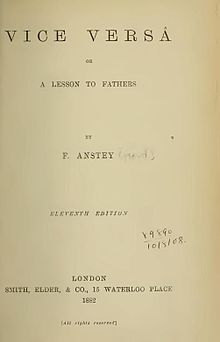Fantasy comedy or comic fantasy is a subgenre of fantasy that is primarily humorous in intent and tone. Typically set in imaginary worlds, fantasy comedy often involves puns on, and parodies of, other works of fantasy.

Robert William Chambers was an American artist and fiction writer, best known for his book of short stories titled The King in Yellow, published in 1895.
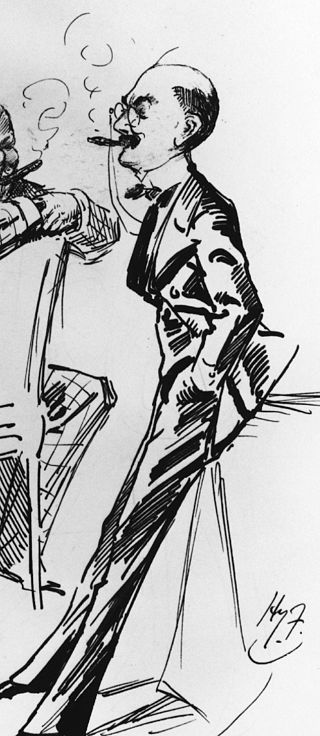
Thomas Anstey Guthrie was an English writer, most noted for his comic novel Vice Versa about a boarding-school boy and his father exchanging identities. His reputation was confirmed by The Tinted Venus and many humorous parodies in Punch magazine.
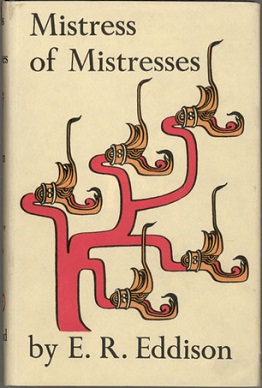
Mistress of Mistresses is a fantasy novel by English writer E. R. Eddison, the first in his Zimiamvian Trilogy. First published in 1935, it centers on political intrigues between the nobles and rulers of the Three Kingdoms of Rerek, Meszria and Fingiswold, following the death of King Mezentius, an extraordinary ruler who has held sway over three kingdoms mainly through force of character. Dissolution of the realm seems certain as alliances are formed and begin to intrigue against each other. The character of Lessingham is an unknown quantity, with a strong character of his own, but the reader is kept uncertain over what impact Lessingham can have over the future of the realm until the novel's close.

A Fish Dinner in Memison is a 1941 fantasy novel by English writer E. R. Eddison, the second in his Zimiamvian Trilogy.
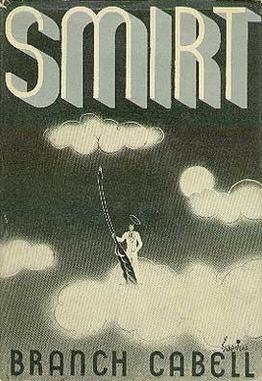
Smirt: An Urbane Nightmare is a 1934 satirical romance novel by American writer James Branch Cabell, the opening volume in his trilogy The Nightmare Has Triplets. The two later romances of this trilogy are Smith and Smire.

The House of Dr. Edwardes is a psychological thriller novel written by John Palmer and Hilary A. Saunders under the pseudonym Francis Beeding.

The Beasts of Tarzan is a novel by American writer Edgar Rice Burroughs, the third in his series of twenty-four books about the title character Tarzan. Originally serialized in All-Story Cavalier magazine in 1914, the novel was first published in book form by A. C. McClurg in 1916.

The Son of Tarzan is a novel by American writer Edgar Rice Burroughs, the fourth in his series of twenty-four books about the title character Tarzan. It was written between January 21 and May 11, 1915, and first published in the magazine All-Story Weekly as a six-part serial from December 4, 1915, to January 8, 1916. The story was first published in book form by A. C. McClurg & Co. in March 1917 and has been reprinted numerous times since by various publishers.

Tarzan and the Jewels of Opar is a novel by American writer Edgar Rice Burroughs, the fifth in his series of twenty-four books about the title character Tarzan. The story first appeared in the November and December issues of All-Story Cavalier Weekly in 1916, and the first book publication was by McClurg in 1918.

Tarzan Triumphant is a novel by American writer Edgar Rice Burroughs, the fifteenth in his series of twenty-four books about the title character Tarzan. The novel was originally serialized in the magazine Blue Book from October, 1931 through March 1932. It should not be confused with the 1943 film Tarzan Triumphs, as the plots are not related.

Tarzan and the Lion Man is a novel by American writer Edgar Rice Burroughs, the seventeenth in his series of twenty-four books about the title character Tarzan. The novel was originally serialized in the magazine Liberty from November 1933 through January 1934.

Tarzan and the Leopard Men is a novel by American writer Edgar Rice Burroughs, the eighteenth in his series of twenty-four books about the title character Tarzan. The story was serialized in The Blue Book Magazine from August 1932 to January 1933, and published in book form in 1935. Its plot has nothing in common with the 1946 film Tarzan and the Leopard Woman.

Tarzan and the Forbidden City is a novel by American writer Edgar Rice Burroughs, the twentieth in his series of twenty-four books about the title character Tarzan. Previous to its publication in book form, it was serialized during 1938 in Argosy magazine under the title The Red Star of Tarzan.
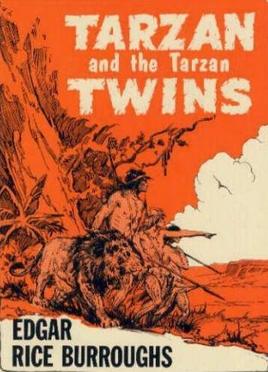
Tarzan and the Tarzan Twins is a collection of two Tarzan novellas by American writer Edgar Rice Burroughs, for younger readers. It was originally published as two children's books, The Tarzan Twins by Voland in October 1927, and Tarzan and the Tarzan Twins, with Jad-bal-ja, the Golden Lion, by Whitman in March 1936. These were brought together in November 1963 under the title of Tarzan and the Tarzan Twins in the first complete edition.

Vice Versa is a 1948 British comedy film written and directed by Peter Ustinov and starring Roger Livesey, Anthony Newley, Petula Clark, and Kay Walsh. It is the third screen adaptation of the 1882 novel Vice Versa by F. Anstey. The film was produced by Two Cities Films and distributed by General Film Distributors.

Vice Versa is a 1988 American fantasy comedy film directed by Brian Gilbert and starring Judge Reinhold and Fred Savage. It is the fourth film adaptation of F. Anstey's 1882 novel of the same name, following the British films released in 1916, 1937 and 1948.
Vice Versa is a 1916 British silent fantasy film directed by Maurice Elvey and starring Charles Rock, Douglas Munro and Guy Newall. It is an adaptation of the 1882 novel Vice Versa by Thomas Anstey Guthrie. The screenplay concerns a schoolboy who magically swaps places with his pompous father.
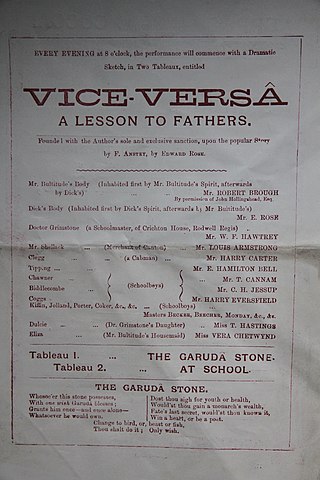
Vice Versa: A Lesson to Fathers is a play by Edward Rose that adapted the 1882 novel of the same name by Thomas Anstey Guthrie. The play debuted at the Gaiety Theatre, London on 9 April 1883. The story is about a body swap between a father and son. Rose played the son in the debut production; Charles Hawtrey played the father.
